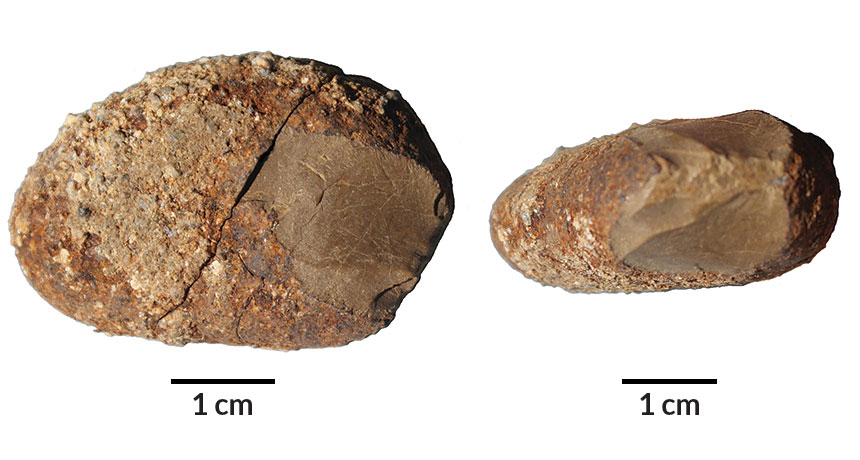


An online article by Bruce Bower on Science News - People roamed tip of South America 18,500 years ago - reports on the stone tools and charred animal bones from Monte Verde which are helping to rewrite human history in the New World.

A 16,000- to 15,000-year-old stone artifact unearthed at Chile's Monte Verde site, shown from both sides, contains smooth areas where pieces of the rock were struck off to create a scraping or cutting tool. Image: Tom Dillehay
Researchers now claim that human groups foraged near the bottom of South America between at least 18,500 and 14,500 years ago, which clearly challenges the popular view in archaeology that people entered South America no earlier than 15,000 years ago.
Archaeologist Tom Dillehay explains that excavations in southern Chile indicate that ancient human groups sporadically passed through that area over a 4,000-year stretch. Discoveries near the previously explored Monte Verde site add to evidence that the earliest New World settlers were not members of the Clovis culture. Clovis people hunted big game with distinctive spear points and camped at sites with large hearths. Clovis sites date to as early as 13,390 years ago in what is now the United States and Mexico.
But Dillehay believes long before that ancient foragers intermittently stopped at Monte Verde. Work at Monte Verde in the 1970s and 1980s yielded stone tools and other remains of a campsite from around 14,500 years ago. New finds include 39 stone artefacts, nine dating to between at least 18,500 and 17,000 years ago. About one-third of these stones consist of rock found outside the Monte Verde vicinity, either near the Pacific coast or further inland. Dillehay explains this by way of early South Americans acquired various types of tool-appropriate rock as they trekked across the landscape and may have traded for some types of rock with other human groups.
Most of these intentionally modified rocks were used for scraping and cutting. A few circular stones were possibly flung at prey with slings. Artefacts also included sharp fragments of stone produced as by-products of toolmaking.
Four stone artefacts were found in soil dating to at least 25,000 years ago. But more evidence is needed to confirm that humans visited Monte Verde and other South American sites before 20,000 years ago.
Dillehay's team also identified 12 soil sections containing ash from small fires, bits of burned wood and nine partial animal bones, five of which were burned or showed signs of heating. The estimated ages for the Monte Verde discoveries come from radiocarbon measures of burned material and soil analyses that estimate when artefacts were buried.
Dillehay suggests that archaeologists searching for further pre-Clovis sites will need to keep an eye out for simple tools and remnants of small hearths or campfires; remains of Clovis sites, which typically feature separate areas for cooking, toolmaking and other activities, are easier to spot.
This research has been published on PLOS: T.D. Dillehay et al. New archaeological evidence for an early human presence at Monte Verde, Chile. PLOS ONE. Published November 18, 2015. doi: 10.1371/journal.pone.0141923.
Follow the human migration and genetic trail on the Journey of Mankind:
http://www.bradshawfoundation.com/stephenoppenheimer/index.php
by Bradshaw Foundation
Monday 03 February 2025
by Bradshaw Foundation
Friday 09 August 2024
by Bradshaw Foundation
Wednesday 24 July 2024
by Bradshaw Foundation
Monday 30 May 2022
by Bradshaw Foundation
Wednesday 19 January 2022
by Bradshaw Foundation
Thursday 06 January 2022
by Bradshaw Foundation
Tuesday 21 March 2023
by Bradshaw Foundation
Tuesday 07 February 2023
by Bradshaw Foundation
Thursday 19 May 2022
by Bradshaw Foundation
Monday 04 December 2023
by Bradshaw Foundation
Friday 30 June 2023
by Bradshaw Foundation
Thursday 06 April 2023
by Bradshaw Foundation
Friday 14 July 2023
by Bradshaw Foundation
Monday 22 November 2021
by Bradshaw Foundation
Tuesday 12 July 2016
by Bradshaw Foundation
Tuesday 26 November 2024
by Bradshaw Foundation
Monday 27 November 2023
by Bradshaw Foundation
Friday 07 October 2022
by Bradshaw Foundation
Monday 03 February 2025
by Bradshaw Foundation
Friday 09 August 2024
by Bradshaw Foundation
Wednesday 24 July 2024
by Bradshaw Foundation
Monday 30 May 2022
by Bradshaw Foundation
Wednesday 19 January 2022
by Bradshaw Foundation
Thursday 06 January 2022
by Bradshaw Foundation
Tuesday 21 March 2023
by Bradshaw Foundation
Tuesday 07 February 2023
by Bradshaw Foundation
Thursday 19 May 2022
by Bradshaw Foundation
Monday 04 December 2023
by Bradshaw Foundation
Friday 30 June 2023
by Bradshaw Foundation
Thursday 06 April 2023
by Bradshaw Foundation
Friday 14 July 2023
by Bradshaw Foundation
Monday 22 November 2021
by Bradshaw Foundation
Tuesday 12 July 2016
by Bradshaw Foundation
Tuesday 26 November 2024
by Bradshaw Foundation
Monday 27 November 2023
by Bradshaw Foundation
Friday 07 October 2022
by Bradshaw Foundation
Tuesday 19 November 2024
by Bradshaw Foundation
Wednesday 22 May 2024
by Bradshaw Foundation
Friday 10 November 2023
Friend of the Foundation











